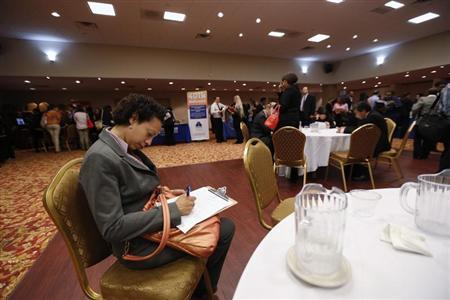(Reuters) – The number of Americans filing new claims for jobless benefits remained at pre-recession levels last week but growth in the massive U.S. service sector cooled in September as firms took on fewer new workers.

The data could provide some of the strongest guidance this week on the health of the U.S. economy as a partial government shutdown delays the release of other data, including the monthly employment report that was scheduled to be released on Friday.
Initial claims for state unemployment benefits edged up by 1,000 to a seasonally adjusted 308,000, the Labor Department said on Thursday.
That was still fewer than seen before the 2007-09 recession, a signal that the long cycle of elevated layoffs has ended. New jobless claims have been falling for much of this year
However, employers have been more reticent about adding new workers to payrolls. The Institute for Supply Management (ISM) said its services index fell to 54.4 last month after nearing an eight-year high in August. The pace of hiring cooled, with the employment sub-index slipping to 52.7 last month, a four-month low.
“Employment readings (in this report) have been choppy from month to month and the swings don’t always correlate with monthly payrolls data,” said Thomas Simons, money market economist at Jefferies & Co. “That said, lower readings are not what you want to see. The services sector is roughly 85 percent of the economy,”
Some economists also doubt whether the claims data still provides a clear signal on the pace of hiring.
Ian Shepherdson, an economist at Pantheon Macroeconomics, said the data was “good news, if only the payroll numbers would tell the same story.”
Still, he said the number was at least consistent with a slightly faster pace of hiring.
The Labor Department’s nonfarm payrolls report, which before the shutdown had been scheduled for release on Friday, was expected to show the economy added 180,000 new jobs last month, compared to 169,000 in August.
A Labor Department analyst said there was nothing unusual in last week’s claims data.
The four-week average of new claims, which smooths out weekly volatility, fell 3,750 to 305,000, the lowest level since May 2007.
The data appeared to have minimal impact on investor sentiment. The dollar was modestly lower against a basket of currencies while U.S. stocks slipped as the government shutdown extended to a third day and leaders in Congress appeared no closer to resolving the stalemate. Prices for U.S. government debt were up slightly.
The shutdown might also start clouding the jobless claims data as well.
While hundreds of thousands of federal workers furloughed this week would be counted separately from the state unemployment benefits data, contractors out of work because of closed government agencies could apply for state benefits, the department analyst said.
The claims report showed the number of people still receiving benefits under regular state programs after an initial week of aid rose by a sharp 104,000. The department analyst said this reflected California catching up on unprocessed claims following an update to its computer processing systems.
A separate report showed the number of planned layoffs at U.S. firms fell 20 percent in September, even as cuts in the healthcare sector more than doubled from the prior month.
Employers announced 40,289 layoffs last month, down from 50,462 in August, according to the report from consultants Challenger, Gray & Christmas, Inc.
(Additional reporting by Steven C. Johnson and Meredith Mazzilli in New York; Editing by Andrea Ricci)





